Contents
Tomato bells have been grown by gardeners for over 20 years. To withstand the “competition” from the domestic and foreign new selections annually put on sale, the variety is helped by its endurance and “stress resistance”, which provides the gardener with approximately the same yields, regardless of weather conditions. In addition, the plants are very compact, do not require particularly complex care, and rarely get sick.
History of occurrence
The tomato variety Bells is listed in the State Register of Breeding Achievements as “The Bells of Our Country”. This is a “joint development” of the Institute of General Genetics named after N. I. Vavilov and the agricultural company Rostock, the achievement of a whole team of authors.
The tomato bells appeared on free sale in 1999. A year later, it was included in the State Register. There are no recommendations regarding the most suitable regions for the cultivation of these tomatoes, the variety is recognized as suitable for planting in any area.

Tomato seeds Bells are produced not only by the originator, but also by other agricultural firms under its license
Description of the variety of tomato bells
bells are an early ripe tomato variety. Tomatoes reach full maturity 103-108 days after seed germination. The State Register recommends growing them in open ground, but they are also suitable for greenhouses, greenhouses, film shelters, due to their small dimensions.
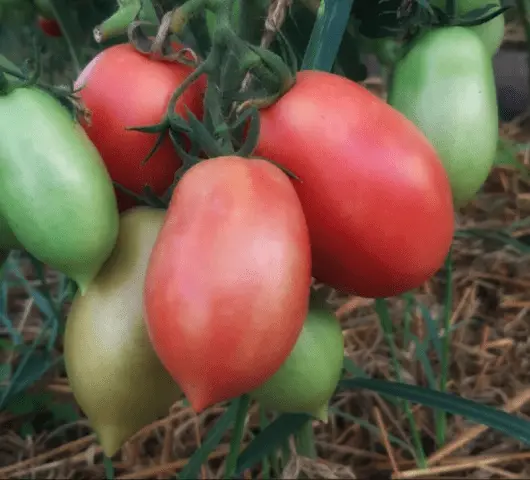
In closed ground, the crop ripening period is reduced to 90-95 days
The variety is determinant. This means that tomato bushes cannot “outgrow” the limit set by the breeders. Their height in the open ground is 45-50 cm, in the greenhouse – a maximum of 60 cm. Standard plants, “squat”, resemble miniature trees. Shoots branch not too willingly, foliage is average. The leaves are quite small, typical for tomatoes form.
Tomatoes are medium-sized, one-dimensional (52-55 g). The skin is smooth, glossy, pink-red. It is thin, but strong, does not crack during prolonged waterlogging, transportation, storage, heat treatment. Tomatoes are easily separated from the stalks, due to the presence of articulation.
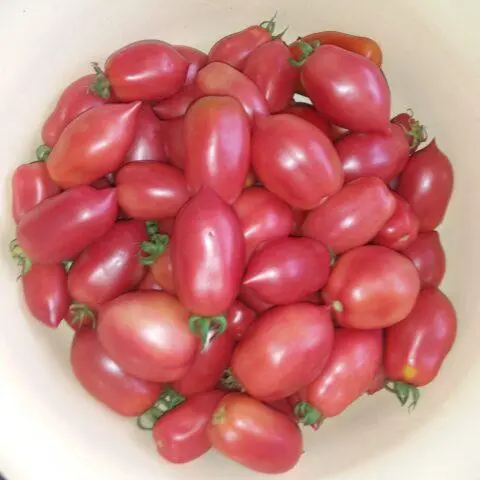
The shape of bells tomatoes varies from plum-shaped with a pronounced “nose” to pear-shaped
The taste is characterized in the State Register as “excellent”. Tomatoes are noticeably sweet, but this is compensated by a slight refreshing sourness. The flesh is raspberry red, juicy, tender, but not watery. It is relatively dense, “grainy” on the cut, with a pronounced “tomato” aroma. In bells tomatoes, there are two seed chambers, there are few seeds, they are small, often underdeveloped.
Characteristics of tomato bells
The tomato bush bells looks very decorative during fruiting – it is literally strewn with tomatoes. But gardeners choose it not only for its visual appeal. The popularity of the variety is determined by its other important characteristics for the summer resident.
Tomato yield bells
The yield for such compact bushes is quite high. With minimal care, you can count on about 3 kg / m². Competent agricultural technology, combined with good weather, can increase yields up to 8-9 kg / m².
Such indicators are provided by the frequent arrangement of fruit brushes. The first is laid over the 6-7th sheet, then they are formed at intervals of 1-2 sheets. Each brush contains up to eight tomatoes (on average – 5-6 pieces).

Tomatoes bells ripen massively, but in several “waves”; because of this, fruiting stretches for a month and a half
Disease and pest resistance
There is no “innate” immunity to diseases typical of Solanaceae in bells tomatoes. However, the general endurance and “stress resistance” characteristic of the variety allow it not only to successfully adapt to the climatic and weather characteristics of different regions, but also to resist pathogenic microflora.
Tomatoes get sick bells rarely, even if fungi and viruses infect their “neighbors” in the garden. The same can be said about pests.
Application area
According to the purpose of the fruit, bells are a universal variety. They are good in salads and cuts of fresh vegetables, thanks to their original shape they can be used to decorate other dishes. This is a suitable “raw material” for homemade ketchup, tomato paste, juice.
Many gardeners grow the Bell variety only for pickling or pickling, noting the exceptional taste of such tomatoes. At home, they look very presentable.

Tomatoes bells are also actively used for cooking soups, vegetable side dishes.
Advantages and disadvantages
Tomatoes bells have been consistently in demand by gardeners for more than 20 years, thanks to a long list of their advantages:
- early ripening of tomatoes;
- “friendly”, but at the same time extended fruiting;
- endurance and “stress resistance”, which ensures stable yields in different regions, which differ greatly in climate and weather conditions;
- ease of cultivation, undemanding;
- the possibility of cultivation in open and closed ground, in the garden or at home;
- good resistance to pathogenic microflora and pests attacking tomatoes;
- consistently good seed germination;
- compactness of plants, which allows to “compact” the bushes without disturbing the planting pattern and facilitating their care;
- one-dimensionality and external presentability of tomatoes, their original shape;
- excellent taste and versatility of the purpose of tomatoes;
- good transportability and keeping quality for tomatoes (up to 15-20 days).
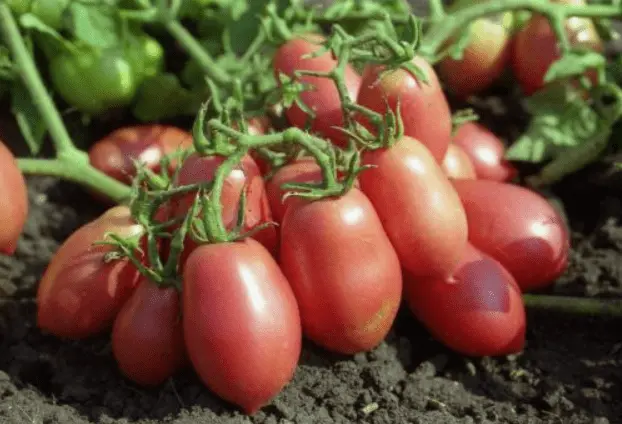
The “presentation” of tomatoes, of course, affects the choice of gardeners
During the entire time of cultivation of tomatoes bells, gardeners could not find any significant shortcomings. A relative disadvantage is the exactingness of the variety to the place of planting and the need for regular top dressing during the entire period of active vegetation. But such “needs” are easily explained by high yields with small bushes.
Peculiarities of growing
gardeners traditionally prefer to grow tomatoes in seedlings. This also applies to the variety bells. Seedlings suitable for transplanting into the ground are formed in 55-60 days.
Knowing how long it takes to grow seedlings, and considering that tomatoes are planted in the ground only when the risk of returning spring frosts is minimized, it is not difficult for a gardener to determine the timing of planting seeds. In central Our Country, this is approximately mid-March, in the southern regions – 2-3 weeks earlier, in “risk farming zones”, on the contrary, later.
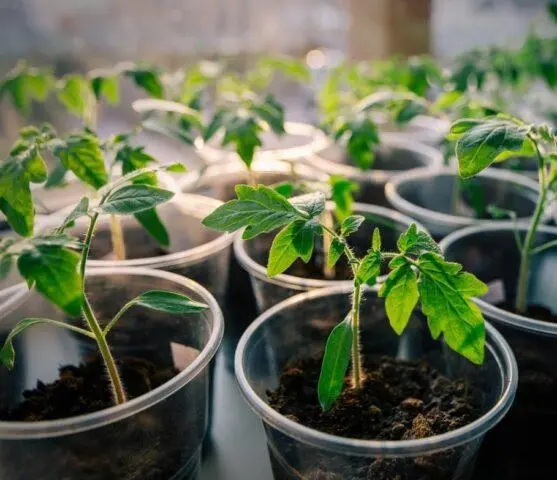
You can plant seedlings 12-15 cm high with 5-6 true leaves on the beds.
It is advisable to immediately plant the seeds in separate containers, in order to then “skip” the stage of diving seedlings. If you use peat pots, you will not have to remove seedlings from them before planting in the ground.
Seedlings quickly adapt to the changed “habitat” and start growing in the garden if they start to harden them a couple of weeks before transplanting. To do this, it is enough to put the containers outside every day, starting from 1,5-2 hours and ending with “overnight stays” in the open air.
Important! The formation of strong seedlings is impossible if the seedlings are not provided with at least 10-12 hours of daylight after germination and the substrate is kept moderately moist.
A bed for tomatoes bells must meet several criteria:
- Good illumination.
- High nutritional value and at the same time friability of the substrate. Its “poverty” can be compensated for by applying fertilizers when preparing the beds.
- Neutral or close to it acid-base balance of the soil.
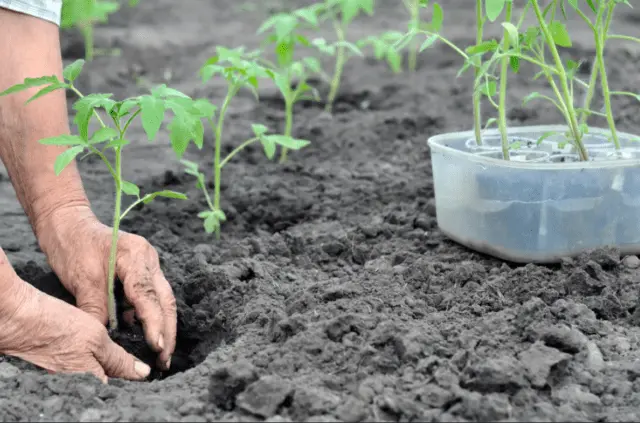
Direct sunlight for bushes and fruits of tomatoes bells are “harmless” even with prolonged exposure
The variety bells is suitable even for beginner gardeners. Agricultural technology includes:
- Watering. Tomatoes planted in open ground, in the absence of precipitation, are irrigated every 3-4 days, spending about 5 liters of water per bush. In the heat, the intervals are reduced to 1-2 days. In the greenhouse, the state of the soil is oriented by watering the bells tomatoes when it dries 2-3 cm deep.
- Loosening and weeding. If immediately after planting the seedlings, the garden bed is mulched, there is no need for these activities. Otherwise, the bushes are loosened about once a week and a half, while getting rid of weeds.
- Top dressing. The first time tomatoes are fertilized 2,5-3 weeks after transplantation. To stimulate the growth of green mass, they need nitrogen. Then, until the end of fruiting, with an interval of 15-18 days, complex fertilizers for Solanaceae are used.
- Bush formation. Tomatoes “lead” in 3-4 stalks. They also need regular (every 10-12 days) pinching and tying fruit brushes.

When grown in a greenhouse, stepchildren are removed more often – every 5-7 days
Pest and disease control methods
The general endurance of tomatoes bells includes their resistance to pathogenic microflora. Although the variety does not have “innate” immunity to any disease, they affect it extremely rarely. Pests are also not interested in them, even with “mass” invasions of the garden plot.
To avoid infection, the simplest preventive measures are enough. It is necessary to choose the right place for planting tomatoes bells, to avoid “crowding” in the garden and serious mistakes in agricultural technology.
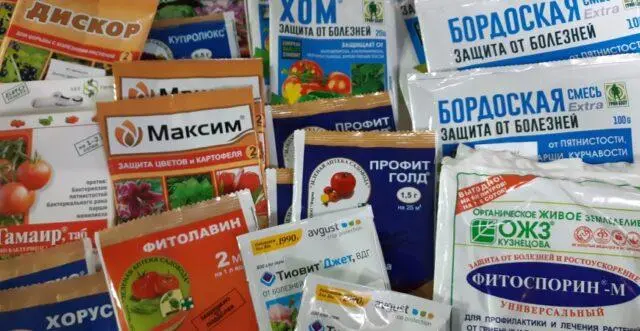
Before planting, it is recommended to treat tomato seeds bells in a fungicide solution
Bushes and soil are sprayed with copper-containing preparations if the weather is favorable for the activation of pathogens.
Conclusion
Tomato Bells is a popular versatile variety. Regardless of the region of cultivation and weather conditions during the vegetative season, it consistently provides gardeners with a crop. The taste of tomatoes is very good, the purpose is universal. Caring for plantings is easy due to the unpretentiousness of the plants and their compactness.









